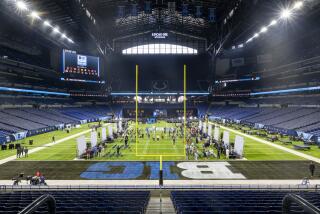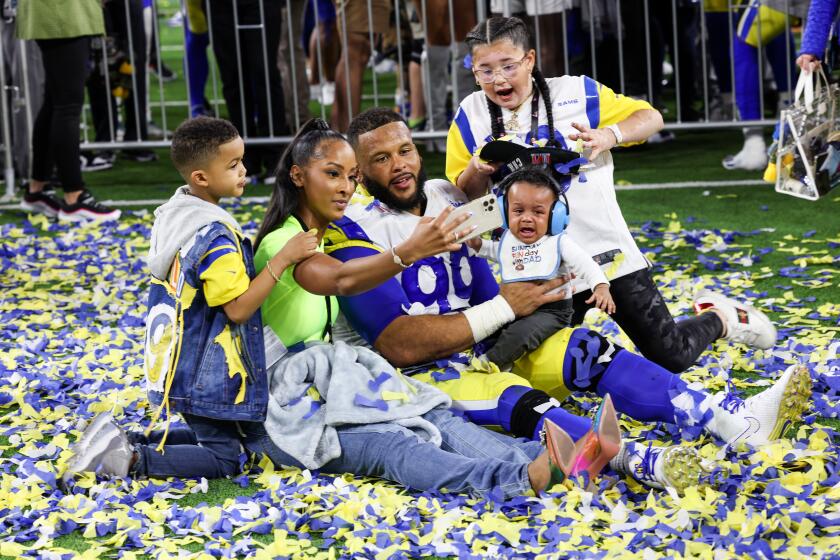System of checks and imbalances
Baseball has been very good to Larry Dierker.
The right-hander tossed a no-hitter late in his 14-year career with the Houston Astros before moving to the broadcast booth and eventually becoming the team’s manager. He also wrote books, newspaper columns and a blog about the game.
For the record:
12:00 a.m. March 1, 2007 For The Record
Los Angeles Times Thursday March 01, 2007 Home Edition Main News Part A Page 2 National Desk 1 inches; 54 words Type of Material: Correction
Sports pensions: An article in Tuesday’s Sports section said former NBA player Bob Elliott was 55 and lived in Phoenix. He is 51 and lives in Tucson. The article also said Elliott earned $22,500 in his rookie year, matching the league minimum in 1977. But Elliott never disclosed his salary for that rookie season.
And in two years, Dierker, 60, will begin to receive $180,000 in annual retirement benefits -- payback for sacrifices made in 1972, when, as a young union representative, he rallied support for baseball’s first strike, over a pension funding dispute with owners.
“Nothing is what most 20-somethings know about pensions,” said Dierker, who earned $125,000 at the height of his playing career and credits longtime players’ union executive Marvin Miller for educating him about the importance of retirement planning. “I didn’t realize how much the time value of money would change things for me over the years.”
Baseball’s pension -- funded in 1947, two years before steelworkers won their pension -- is the gold standard for union-represented athletes. But even its plan, which is relatively lucrative when compared with those offered by the NFL and NBA, has drawn criticism from former players who failed to win benefits or have seen the value of their monthly checks eroded by time and inflation.
The resentment now spans those three major American professional sports leagues and has only grown in recent years as franchise owners and current athletes enjoy the financial wealth created by lucrative broadcast rights deals.
Contrast what baseball will pay Dierker to what the NFL will provide former lineman Conrad Dobler, who at 56 would receive $24,000 annually if he were to immediately begin taking his pension -- or $48,000 if he could unsnarl his finances and delay retirement until age 62.
The 10-year NFL veteran, who has had several knee operations and other ailments, maintains that he can’t afford to take his relatively small pension now because doing so would preclude him from pursuing a long-contested disability claim with the NFL Players Assn.
“We’re not begging, and we’re not trying to take something we don’t think we deserve,” Dobler said. “We’re simply trying to get back something that we worked so hard to get in the first place.”
The bad blood is the result of a generational conflict that is unique to the sports world.
“The soul of unionism, whether we’re talking coal miners in the 19th century, janitors today or NBA players, is solidarity,” said University of California professor Harley Shaiken, who studies labor issues. “You are working together to improve everyone’s position.”
Union members typically work for decades, which gives them plenty of time to protect long-term interests. But professional athletes have brief careers, lose their union vote after their final game, and must depend upon subsequent generations to safeguard their retirement interests.
Federal law requires union leaders to represent the interests of current and future players rather than aging athletes, so improvements to previously negotiated benefits must be approved by current union members -- and often by the franchise owners who foot the bills.
Many old-timers argue that today’s athletes and owners have a moral obligation to care for players whose sacrifices set the table for today’s eye-popping salaries, improved playing conditions and the soaring value of professional sports franchises.
“We won a pension plan by tearing it out of the hides of owners who had us under slave contracts,” said Bernie Parrish, a defensive back with the Cleveland Browns during the 1960s and now a fierce critic of the NFL Players Assn.’s treatment of old-timers. “We won the pension plan that is a gift to today’s players. But the older guys have been getting” a bad deal.
The generation gap is most evident in the NFL.
Retired NFL stars Mike Ditka and Jerry Kramer recently used a Super Bowl XLI news conference to promote a sports memorabilia auction to raise money to benefit retired football players.
Former Los Angeles Rams great Merlin Olsen is working with the Pro Football Hall of Fame to find sports marketing opportunities for former players. And Parrish is pressing Congress, which already has held one hearing, to dig deeper into his former union’s retirement and disability plans.
“It’s just disgusting,” said Kramer, a former Green Bay Packers star who receives a $358 monthly football pension. “The physical and economic hardships many guys are forced to live with are due to the lack of an adequate pension and disability package.”
Old-timers have been especially harsh in their criticism of Gene Upshaw, a former player who is the union’s executive director. The NFL Players Assn. repeatedly declined requests in recent months to discuss pension and retiree medical benefit plans. But, during a Feb. 2 news conference, NFL Commissioner Roger Goodell acknowledged that football should “reevaluate to see what we can do more to address the issues and we’ll do that.”
Whereas today’s NFL players will qualify for severance pay, an annuity program, tuition reimbursement and a fund designed to help cover some future medical bills on top of their pension check, Dobler and others allege that the union and league are ignoring older retirees who played before salaries soared.
“It’s as if we invested in this company called the NFL and we watched it grow to $6 billion in sales, yet our stock is still only worth $100,” Dobler said.
Last year, Pro Football Hall of Fame member Herb Adderley protested his $126 monthly pension check as “below poverty level.” A recent pension upgrade approved by the NFLPA will boost monthly checks for all retirees by a minimum of $50, but the former Packers defensive back says it isn’t enough and is refusing to wear his Super Bowl and Hall of Fame rings.
The other big leagues also have drawn criticism.
For years, the NBA had different pre- and post-1965 service requirements: five years before; three years after. A new agreement -- in addition to increasing the maximum annual pension benefit for a 10-year veteran from $124,000 to about $170,000 -- will make pensions available to dozens of players who accumulated three or four years of service before 1965. The plan also includes a death benefit to a player’s widow.
Even baseball’s gold-plated pension has drawn criticism from some former players -- unrest that dates to 1980, when the MLB Players Assn. reduced the time it took for players to qualify for a pension from four years to one day.
The rule change didn’t help players such as Carmen Fanzone, a third baseman for the Chicago Cubs during the 1970s. Fanzone, now 65, was cut by the Cubs just a few weeks short of the four years needed to vest. Baseball has talked about making the one-day rule retroactive, but it hasn’t yet happened.
“It used to eat me to death thinking about it,” said Fanzone, who carried a trumpet with him on the road and subsequently earned a living and a pension as a professional musician. “After I got cut, I called every club, but got no answer. Then I broke my ankle and couldn’t come back.”
Craig Skok was luckier. A pitcher who for years knocked around the minor leagues, Skok knew it was highly unlikely he’d ever be called to the big leagues. So he made his own call -- to Ted Turner, then the Atlanta Braves’ owner. Turner agreed to put the left-hander in the bullpen for two weeks, and even though Skok never entered a game he thus qualified for a $1,000 monthly pension.
Skok and other retired ballplayers unsuccessfully tried to persuade team owners to help fund benefits for players whose careers predated the 1980 rule change. The attempt was derailed, Skok said, after a separate group of players unsuccessfully sued Major League Baseball for pension benefits.
Former Montreal Expos pitcher Steve Rogers, who now oversees pension issues for the MLBPA, said the union recognizes its obligation to past players. “Each time we negotiate, we try to reach back a minimum of 10 years to get current benefits extended back in time,” Rogers said. “There are now guys from the 1950s and 1960s who are earning benefits that are five or 10 times higher than what they earned while they were playing.”
Miller, the baseball union’s longtime executive director, said that he constantly reminded younger players of the need to care for past generations. During the 1960s, Miller invited widows of former baseball greats to speak to young players about their daily struggle to make ends meet with their then-miserly pensions.
“Along with creating self-interest, I wanted to establish an ironclad precedent that this is what you do -- you take care of older people who came before you,” Miller said.
Athletes who’ve been fortunate enough to be paid to play their beloved games acknowledge that it often is difficult for fans and today’s players to empathize with aging athletes.
“The fallacy is that these guys played in the big leagues, so they must all have money,” said Robert A. Elliott, a former center with the New Jersey Nets who is now a Phoenix accountant and investment advisor.
Elliott, now 55, earned $22,500 during his rookie year in 1977 and never earned a six-figure salary during his three-year NBA career. Elliott’s monthly check will grow beyond the $3,200 he has been promised at age 62, thanks to the newly reworked pension. But many former athletes fall upon hard times financially and opt to take pensions earlier -- a practice that dramatically reduces monthly benefits.
“An awful lot of guys never thought about what they’d do after playing football,” said Olsen, the Hall of Fame defensive tackle who enjoyed post-football success in sports broadcasting and Hollywood. “For many, that turns out to be a fatal mistake. They never found anything to replace the incredible chunk of life that was the game. Emotionally, it leaves them crippled ... and, financially, many of them never catch up.”
Although baseball players can begin to earn pension benefits during their first professional game, it is harder for athletes in other sports to qualify for pensions. The NFL and NBA each require three years of service.
In the NFL, that’s just a little less than the span of an average career, which is just under four years. “That means a lot of guys in the league are getting some pretty limited benefits,” said Ken Ruettgers, a former USC offensive lineman who played a dozen years with the Packers and now operates a program that helps pro football players transition into new careers.
League and union officials maintain that they have addressed real and perceived pension injustices.
Baseball owners in 1997 went so far as to create a charitable trust that provides pension-like payments to black athletes who, for generations, were locked out of what long was an all-white club.
The NFL has created funds that benefit players with financial and medical hardships. And even before the recent pension upgrade, the NBA had authorized lump-sum payments to some “pre-1965” players.
Yet it isn’t enough for some old-timers.
Butch Byrd, 65, a defensive back with the Buffalo Bills in the 1960s who still holds a few team records, qualifies for about $60,000 annually -- about double what he earned during his playing days -- because he could afford to wait before drawing his pension.
He knows he’s lucky. “A lot of guys, for whatever reason -- sickness, personal reasons and whatnot -- had to take it early,” he said.
Now, word has spread among NFL alumni that Byrd, who leads the New England chapter of a retired players’ association, is a go-to guy for veterans and their widows.
“On some days I hate to pick up the phone,” Byrd said. “Because by virtue of a conversation with someone, I’m putting hope into their minds -- and you don’t know for sure that you’re going to be able to deliver.”
Aaron Taylor, who won a Super Bowl ring with the Packers in 1997 and now leads a Southern California NFL alumni group, shares the concern.
“The NFL is a multibillion-dollar business, but it’s a shame and quite sad, frankly, to see men who were once warriors and stood proud on the football field, to be disabled, or to have [the league] they dedicated lives and bodies to be unsympathetic to their situation.
“It would be like the [knights] serving the king coming back from the battlefield bloody and bruised and the king essentially says, ‘Too bad.’ ”
--
*
(BEGIN TEXT OF INFOBOX)
Three plans
Plans for major sports. Information is as of end of fiscal years in February and March 2005:
MAJOR LEAGUE BASEBALL
* Year originated: 1947.
* Participants: 7,403.
* Maximum annual benefit: $180,000 for a 10-year veteran who takes retirement at age 62.
* Net assets: $1.5 billion.
--
NFL
* Year originated: 1959.
* Participants: 9,560.
* Maximum annual benefit: $49,860 for 10-year veteran who takes retirement at age 62.
* Net assets: $841,761,127.
--
NBA
* Year originated: 1965.
* Participants: 1,328.
* Maximum annual benefit: $170,000 for 10-year veteran who takes retirement at age 62.
* Net assets: $121,122,852.
--
Source: Federal filings, players’ unions, leagues
More to Read
Go beyond the scoreboard
Get the latest on L.A.'s teams in the daily Sports Report newsletter.
You may occasionally receive promotional content from the Los Angeles Times.










